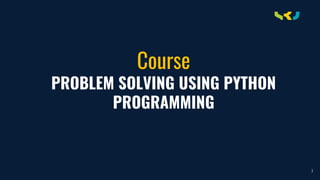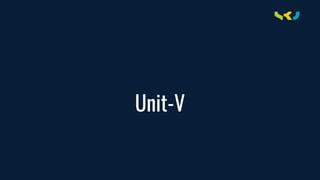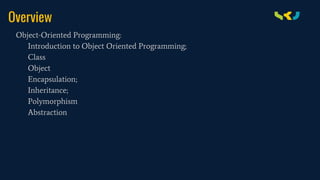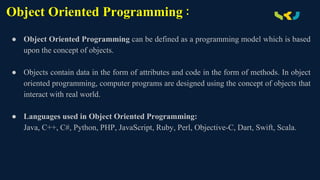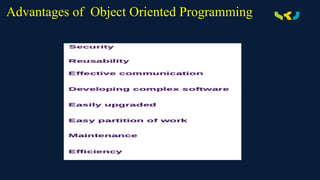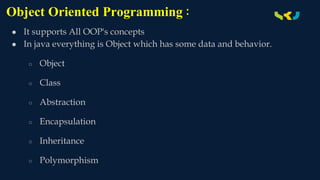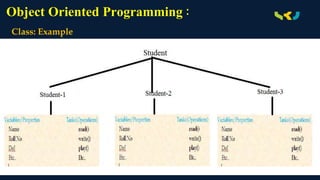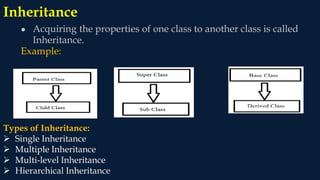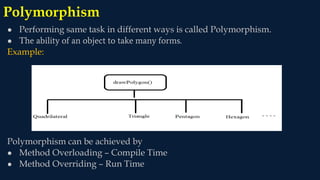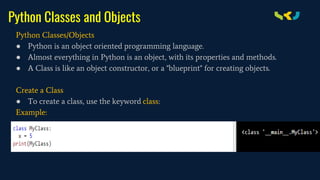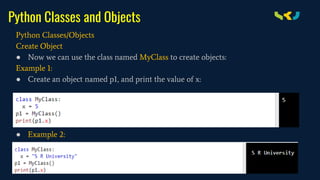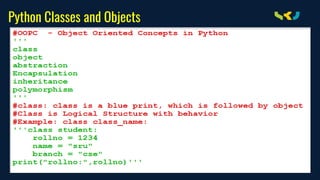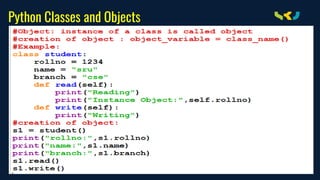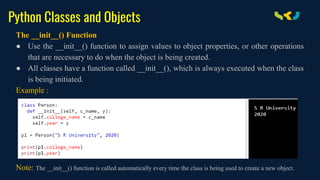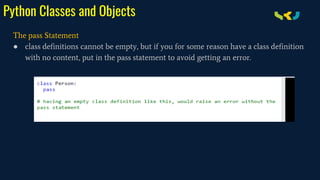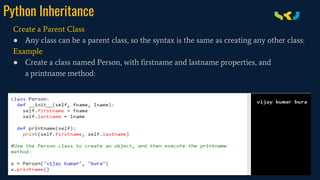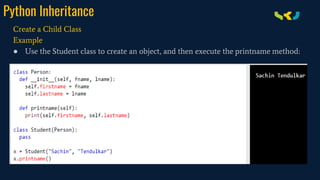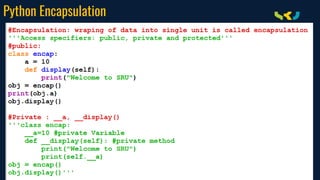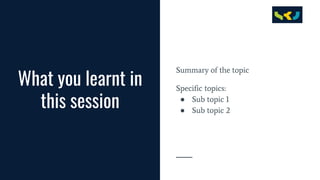Problem solving with python programming OOP's Concept
- 2. School of Computer Science & Artificial Intelligence Bura Vijay Kumar Assistant Professor, Email : b.vijaykumar@sru.edu.in 2
- 3. Course PROBLEM SOLVING USING PYTHON PROGRAMMING 3
- 4. Unit-V
- 5. Overview Object-Oriented Programming: Introduction to Object Oriented Programming; Class Object Encapsulation; Inheritance; Polymorphism Abstraction
- 6. Object Oriented Programming : ● Object Oriented Programming can be defined as a programming model which is based upon the concept of objects. ● Objects contain data in the form of attributes and code in the form of methods. In object oriented programming, computer programs are designed using the concept of objects that interact with real world. ● Languages used in Object Oriented Programming: Java, C++, C#, Python, PHP, JavaScript, Ruby, Perl, Objective-C, Dart, Swift, Scala.
- 7. Advantages of Object Oriented Programming
- 8. Object Oriented Programming Concepts ● Procedural Vs Object Oriented
- 9. Object Oriented Programming : ● It supports All OOP's concepts ● In java everything is Object which has some data and behavior. ○ Object ○ Class ○ Abstraction ○ Encapsulation ○ Inheritance ○ Polymorphism
- 10. Object Oriented Programming : Object: ● Object is an Real world Entity ● Instance of a class is called an Object. ● It has properties (attributes) ● Task performed (operations) Example: Human Attributes/Properties Tasks(Operations) Name walk() Color run() Height read() Etc.. Etc..
- 11. Object Oriented Programming : Class: ● Class is a blue print that object follows ● A Class consist of ‘N’ Number of Object. ● Class is a collection of objects and there attributes, operations and there relationships Example: Student Variables/Properties Tasks(Operations) Name read() Roll No write() DoJ play() Etc.. Etc..
- 12. Object Oriented Programming : Class: Example
- 13. Abstraction ● Showing only essential parts, hiding the implementation details is called Abstraction. Example: Google play Store Android Applications .apk files .exe files
- 14. Encapsulation ● Binding Variables and Methods under single Entity or ● Wrapping of data into Single Unit is called Encapsulation. Example:
- 15. Inheritance ● Acquiring the properties of one class to another class is called Inheritance. Example: Types of Inheritance: Single Inheritance Multiple Inheritance Multi-level Inheritance Hierarchical Inheritance
- 16. Polymorphism ● Performing same task in different ways is called Polymorphism. ● The ability of an object to take many forms. Example: Polymorphism can be achieved by ● Method Overloading – Compile Time ● Method Overriding – Run Time
- 17. Python Classes and Objects Python Classes/Objects ● Python is an object oriented programming language. ● Almost everything in Python is an object, with its properties and methods. ● A Class is like an object constructor, or a "blueprint" for creating objects. Create a Class ● To create a class, use the keyword class: Example:
- 18. Python Classes and Objects Python Classes/Objects Create Object ● Now we can use the class named MyClass to create objects: Example 1: ● Create an object named p1, and print the value of x: ● Example 2:
- 19. Python Classes and Objects
- 20. Python Classes and Objects
- 21. Python Classes and Objects The __init__() Function ● Use the __init__() function to assign values to object properties, or other operations that are necessary to do when the object is being created. ● All classes have a function called __init__(), which is always executed when the class is being initiated. Example : Note: The __init__() function is called automatically every time the class is being used to create a new object.
- 22. Python Classes and Objects Object Methods ● Objects can also contain methods. Methods in objects are functions that belong to the object. ● Let us create a method in the Person class: Example ● Insert a function that prints a greeting, and execute it on the p1 object:
- 23. Python Classes and Objects The self Parameter ● The self parameter is a reference to the current instance of the class, and is used to access variables that belongs to the class. ● It does not have to be named self , you can call it whatever you like, but it has to be the first parameter of any function in the class: Example: ● Use the words my_object and abc instead of self :
- 24. Python Classes and Objects Modify Object Properties ● You can modify properties on objects like this: Example:
- 25. Python Classes and Objects Delete Object Properties ● You can delete properties on objects by using the del keyword: Example: ● Delete the age property from the p1 object:
- 26. Python Classes and Objects The pass Statement ● class definitions cannot be empty, but if you for some reason have a class definition with no content, put in the pass statement to avoid getting an error.
- 27. Python Classes and Objects Python Inheritance ● Inheritance allows us to define a class that inherits all the methods and properties from another class. ● Parent class is the class being inherited from, also called base class. ● Child class is the class that inherits from another class, also called derived class.
- 28. Python Inheritance In Single Inheritance one class extends another class (one class only).
- 29. Python Inheritance ● In Multilevel Inheritance, one class can inherit from a derived class.
- 30. Python Inheritance ● In Hierarchical Inheritance, one class is inherited by many sub classes.
- 31. Python Inheritance ● In Multiple Inheritance, one class extending more than one class.
- 32. Python Inheritance Create a Parent Class ● Any class can be a parent class, so the syntax is the same as creating any other class: Example ● Create a class named Person, with firstname and lastname properties, and a printname method:
- 33. Python Inheritance Create a Child Class ● To create a class that inherits the functionality from another class, send the parent class as a parameter when creating the child class: Example ● Create a class named Student, which will inherit the properties and methods from the Person class: class Student(Person): pass Note: Use the pass keyword when you do not want to add any other properties or methods to the class. ● Now the Student class has the same properties and methods as the Person class.
- 34. Python Inheritance Create a Child Class Example ● Use the Student class to create an object, and then execute the printname method:
- 35. Python Inheritance Use the super() Function ● Python also has a super() function that will make the child class inherit all the methods and properties from its parent: class Student(Person): def __init__(self, fname, lname): super().__init__(fname, lname)
- 39. What you learnt in this session Summary of the topic Specific topics: ● Sub topic 1 ● Sub topic 2
- 40. If any questions Question 1 ● Option 1 ● Option 2 ● Option 3 ● Option 4 ● Option 1 ● Option 2 ● Option 3 ● Option 4 Question 2


